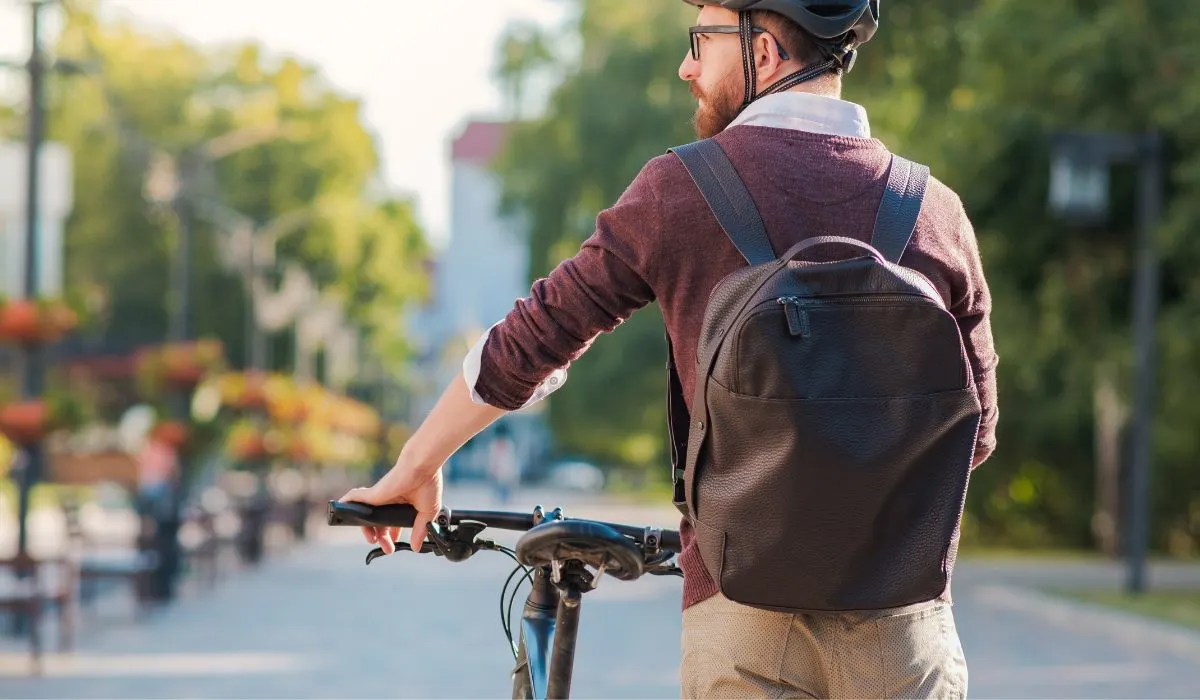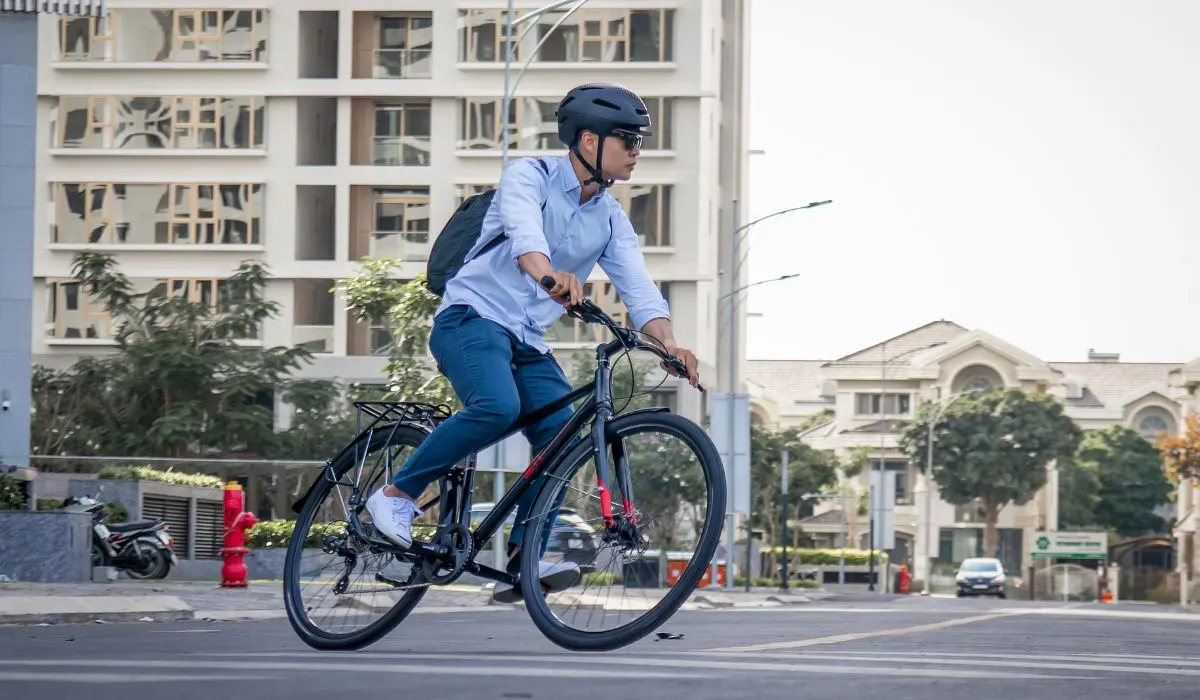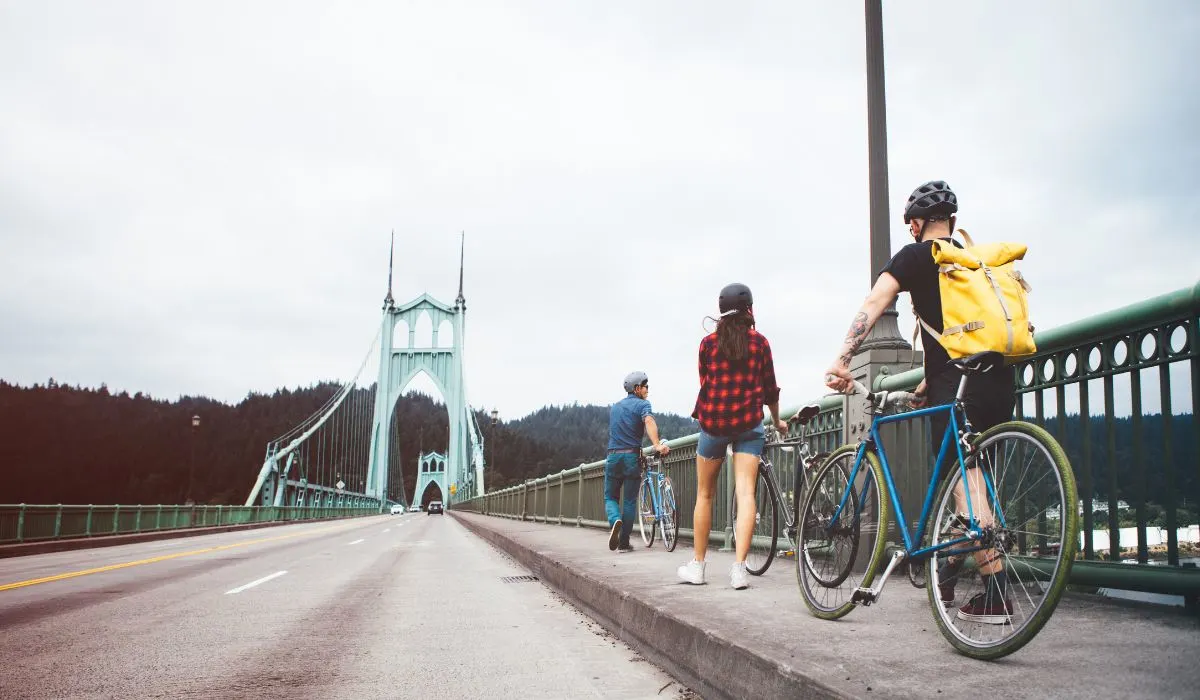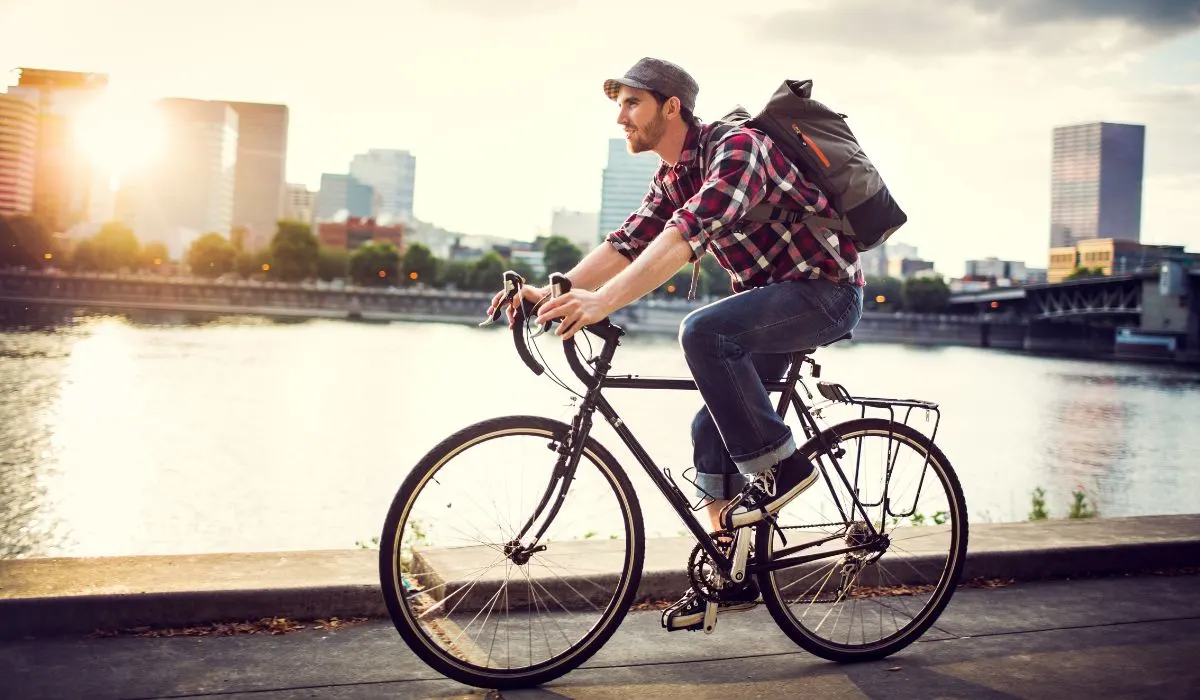
There are plenty of reasons to bike commute to work. You’ll save money on gas and have a lower environmental impact. Riding a bike daily will improve your health and help you stay mentally alert. Best of all, it’s a lot of fun.
- How do you commute to work on a bike?
- What type of bike should you be using?
- How can you stay safe while riding?
Let’s look at everything you need to know about using a bike on your daily commute.
Pick the Right Bike
The first thing that you need to do is pick the right bike. This will have a big impact on how comfortable you feel riding. There are a few things to look for when picking the ideal commuter bike.
First, decide what type of commuter bike you want. For example, some people might need storage on the back to help them carry everything they need. Others will desire an electric bike, which can be ideal for traveling up steep inclines.
Next, make sure it has a padded seat that is comfortable. Look for a saddle that can adjust and find the position that suits you the best. Often, this will be in an upright position rather than leaning forward.
Consider getting a bike that has fenders, or add them if they don’t come included. Fenders keep your clothes clean by catching:
- dirt
- water
- mud
Adjust the height if necessary. How tall the bike is depends on your height. Measure your inseam to know the best size bike to purchase.
Start Slowly
Once you’ve found the perfect bike for you, it’s important to start slowly if you aren’t used to a daily ride. If you are a long way from work, ride part of the way and catch public transport the rest of the way. Or, ride in to work, but take public transport home.
Start with small, achievable goals. For example, if work is 40 miles away, for the first few weeks aim for 10 miles. Then, increase to 20 miles, and so on. Use fitness trackers to know how much distance you are covering.
When you first start riding, your muscles will take a while to adjust but don’t give up. Turn a daily bike commute into a habit by setting the same time each day to ride.
It helps to prepare the night before:
- make your lunch
- pack your bag
- lay your clothes out
When you wake up in the morning, everything is ready which is a great way to eliminate any excuses that might prevent you from cycling.
Take Safety Seriously
Getting into an accident on a bike can be very serious. There are plenty of simple things that reduce the risk.
First, make sure that you get a good helmet. In some places, you might be legally required to wear a helmet while you are cycling.
To pick the right one, look for a good fit. It shouldn’t be loose, but it shouldn’t be so tight that it’s uncomfortable.
Next, check its safety qualifications. It should be tested and approved. Then think about aesthetic considerations like color and shape. Getting a high-quality helmet is important and affordable.
Another important safety element to consider is the type of lights on the bike. Lights make it easier for other road users to see you.
Put a red flashing light on the back of the bike and a solid white light on the front. If you’re in low light conditions, use a more powerful light so you can illuminate the road. This set of lights on Amazon is really good value.
It’s important to make sure that you have visible clothing that other road users will be able to see. Try reflective clothing or a high-visibility vest like this one found on Amazon.
Finally, remain vigilant while you’re riding. Potential hazards that you might encounter are:
- someone opening a car door, forcing you to swerve out of the way
- potholes, which can shake you from the bike
You must have a good brake system to stop quickly and prevent a serious accident.
Build Your Confidence
Though safety equipment is important, your behavior determines how you perform on a bike and will build confidence in your cycling abilities.
First, stay in the bike lane without hugging the sidewalk. Position yourself in the middle of the bike lane.
To move from one side of the road to another, always look behind you to check that no cars are coming. Put yourself in the middle of the lane to ensure that no one will get past you. Move quickly to stay with traffic.
When riding on roads, know the correct hand signals to communicate with drivers. Sticking out the right arm that you intend on turning right and a left arm at a right angle shows that you’re ready to turn left.
Filter through the traffic during a traffic jam, but make sure to be safe while you’re doing this. If you are in the blind spot of a car, they can’t see you. This can be very dangerous, so it’s best to assume that the driver hasn’t seen you, acting cautiously.

Plan Your Route
Before you start riding, take the time to plan your route. Use a map of the area to consider all the possible routes that you can take to get to work. Aim to avoid heavily trafficked areas and places with a lot of people. Even if it adds a few minutes to the commute, you’ll be a lot safer.
Once you’ve narrowed it down to a few potential routes, take the journey in a car to see any potential obstacles. For example, one route might have a steep hill to climb.
TIP: Driving the route will help you memorize it, so you won’t get lost.
Finally, pick a weekend to do a dry run. Ride into work and back home to know how long the journey will take and how physically exhausting it is.
Leave Plenty of Time
Plan what time to leave home, and leave plenty of extra time so you aren’t racing to get into the office. Don’t forget time to freshen up before starting work after the bike ride.
Leave some spare time to deal with unexpected events. For example, if a tire gets punctured, you can deal with it without worrying about being late for work. Or, if necessary, time for a colleague to pick you up.
If riding to improve fitness, find time to push yourself harder on the return journey home so you can shower immediately after. This is better than arriving to work sweaty and out of breath.
Be Prepared for Emergencies
Commuting to work should be:
- a nice way to start the day
- get some fresh air
- exercise
But things don’t always go according to plan. There will be times when you have mechanical problems like puncturing a tire or have a problem with one of your gears. At these moments, make sure that you’re prepared with these simple tips.
Carry a puncture kit in your saddlebag that contains the basics to fix a hole in your tire. The patch should be strong enough to get you to work and back. Once home, perform a more thorough assessment to see if the tire needs to be replaced.
Make sure that you have a tire pump in your saddlebag too. Try these small pumps:
- mini-pump
- CO2 canister pump
One of the most important tools to carry is a mobile phone to call for help if you ever need it. If you run into serious issues, a co-worker or family member might be able to give you a lift.
One of the best ways to prevent serious problems is to maintain the bike regularly. It doesn’t take a long time to do the weekly basics like lubing the chain.
NOTE: For more advanced maintenance, take it to a bike shop.

Get a Reliable Backpack
If you need to take important documents with you, use a cargo bag like this one from Amazon to keep your items safe from the elements. To get everything you need on a bike, some are equipped with storage racks. If not, it can be added later.
However, if you don’t need to take a lot with you, it can be wise to purchase this kind of backpack instead (Amazon link). Pick one with comfortable straps and before riding, adjust the bag so it is sitting across your back.
Keep Your Bike Secure
Once you arrive at work, use a bike lock to secure your bike properly. First, lock the bike to a secure object, and avoid anything that can be lifted and moved away.
Be careful about the area you are locking the bike. If your work has a secure car park, this can be a great choice. If not, find a well-lit area. Look for an area that has a lot of foot traffic because thieves will be more reluctant in these areas, as there is a strong chance that they will get caught.
To make your bike less of a target, remove any expensive accessories. If a thief is knowledgeable, they will be able to identify these valuable components. Pop these into your bag and take them to work with you.
Invest in a good bike lock that can’t be cut easily. Try to avoid chain locks, a U-lock is the best option and tends to be the hardest to get through.
Pick the Right Cycling Clothes
Decide on the right clothes to wear during the commute to work. There are a few options to consider, depending on the type of commute.
If it is a short trip, wear the clothes that you’ll be wearing during the day. You don’t need to wear a jersey if you don’t want to.
However, for a longer journey, wear cycling shorts to stay comfortable. They have padding to protect you from intense bumps.
When riding in the winter months, pick clothes that will keep you warm. Use a jacket like this one (Amazon link) that protects you from the wind and is waterproof.
It’s also a good idea to wear gloves like these (Amazon link) to protect your fingers from the cold and still maintain a grip on the bike.
When You Arrive at Work
When you arrive at your destination, you might want to freshen up if you feel sweaty and gross. How you do this will depend on the type of facilities that your office offers.
Ideally, you’ll be able to use a shower. If so, get a lightweight towel; I like this hiking towel on Amazon. It folds into a tiny package, making it super easy to keep in a backpack.
If there’s no shower, don’t fret. First, have a change of clothes. After a long journey, use body wipes or a damp towel. Finish with a packable deodorant.
TIP: Make sure to leave enough time to perform this routine when you arrive at the office.
If you don’t have a shower at work, it’s a good idea to wear clothes made of smart fabrics. These have been designed to absorb and wick away your sweat and will reduce odors.
Also, keep some dry clothes at work since the weather can be unpredictable. Even if it looks like a sunny day, there can still be rain, and you’ll be prepared.
Riding in the Rain
One of the most common problems that people face when commuting to work is the rain. There are a few ways to get around this problem.
Wear a waterproof jacket and pants, and take a dry pair of clothes in your bag in a waterproof sack to keep them from getting wet.
When riding in the rain, protect your feet from getting wet and blistered. Put plastic baggies over the rim of your biking shoes to act as a seal and stop water from getting inside.
PRO TIP: If your feet are still wet when you get to work, put newspaper in your shoes to absorb any excess moisture.
The bigger concern, though, is the bike. When it’s raining, you’ll have less traction and the bike tires can lose their grip, especially at sudden stops. If you change the tires to wet tires, the water will be channeled through the groves, giving more grip on wet days. These are ideal during the rainy season.
Stay Hydrated
During warmer days, you’ll be likely to lose a lot of moisture because of sweat. The best way to protect yourself from this is by staying hydrated. Keep a water bottle on the bike and schedule stops along the way to drink. The hotter the day, the more frequently you will need to stop for water.
If you don’t need to ride with a backpack, think about using a hydration pack like this one from Amazon with a water bladder and a connected hose. When riding, you can grab a drink without needing to stop, which is an ideal solution for the summer months. (I love using these!)
Riding During the Winter
Many cyclists avoid riding during the winter months. Rain and snow make you cold and wet when you arrive for work. With a few simple preparations, you’ll be able to brave the colder conditions.
Focus on getting the right winter clothes like a waterproof jacket that’s insulated to preserve your body heat. To keep the snow out, take the same precautions discussed for rainy days.
Prepare your bike for colder conditions as well. In the winter snow and ice build up on the paths, creating treacherous conditions for riders.
During the winter, use thicker tires like these ones from Amazon with deeper treads. They are better prepared to handle the uneven ground.
If the snow in your area is particularly thick, you might want to get tires with metal studs like these from Amazon. These will give a lot more grip, but if the conditions get too bad, ride slower.
The cold weather can also take a toll on your equipment, so maintain your bike more regularly in the winter. Keep your chain and cassette clean, protecting against salt, and lubricate them more often. Change the tape around your handlebars and saddle more regularly.

Final Thoughts
Riding your bike to work can be a highly rewarding experience, staying fit while saving money. As we’ve seen, riding to work doesn’t need to be a complicated task. By taking a little time to prepare, you’ll be ready to face anything on your morning commute.
Who knows, it might even be more fun than driving!
You might also be interested in:
